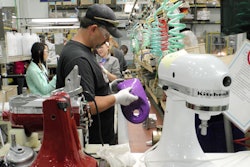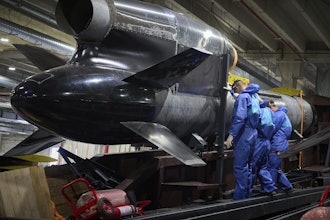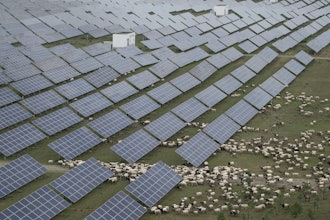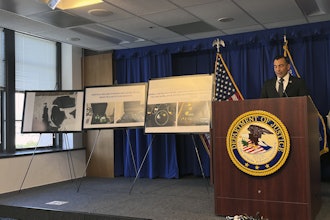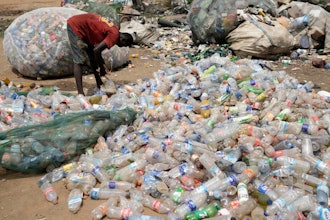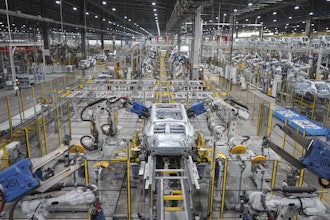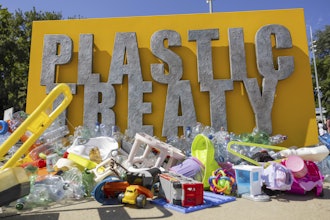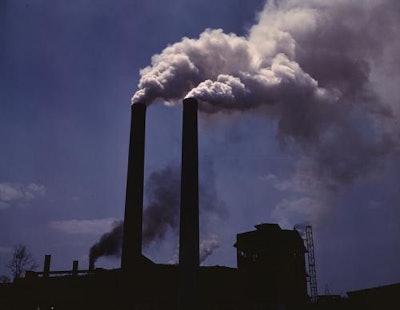
This article originally appeared in the August print issue of IMPO.
The battle between the Environmental Protection Agency (EPA) and industry has been arduous — marked by heated debates and expensive lawsuits. The EPA, as well-intentioned as it may be, is often met with staunch opposition from the industrial sector and the political right. Backing the EPA, more frequently than not, are environmentalist and the left. But who’s right, and is there a clear winner?
For the sake of brevity, let’s look specifically at the most recently proposed plan by the EPA, its fate in the Supreme Court and what it means for American manufacturers.
What Was Proposed?
On June 2, 2014, the EPA proposed a Clean Power Plan that would cut carbon dioxide emissions from existing coal plants by up to 30 percent by 2030 compared with 2005 levels. The aim of this regulation was to cut the nation’s leading source of greenhouse gases (GHG). According to the EPA, the average coal plant in the United States is 42 years old, meaning that most of them aren’t nearly as efficient as the new ones.
The proposal would require states to meet the standard with the option of mixing between a menu of options: energy efficiency, shifting from coal to natural gas, investing in renewable energy and making power plant upgrades to name a few. Other compliance methods could include offering discounts to encourage consumers to shift electricity consumption to off-peak hours.
This contentious proposal represented one of the most significant steps the federal government has ever taken to address GHG production in the nation, which is linked to climate change. This initiative, however, was seen as an abuse of power by many groups in the country, and was quickly challenged on its legal merits.
The main point of legal contention oriented around interpretations of the Clean Air Act stemming from the Bush administration. In 2007, in the Massachusetts v. EPA case, the court ruled that carbon dioxide and other GHGs are pollutants that can be regulated under the Clean Air Act. The case in question, however, concerned regulating vehicles.
Using this case as fodder, the Obama Administration reasoned that “stationary sources,” including factories and power plants, were also subject to these permitting requirements. As is characteristic of recent years in American politics, viewpoints on the issue split along party lines and their usual allies. Those sides are presented below.
“Regulations Will Harm American Manufacturing”
Many Republicans argued that the standard was an overreaching interpretation of the Clean Air Act, and that the Obama Administration was abusing its executive power.
Conservative think-tanks like The Heritage Foundation fought hard against the legislation and released an issue brief titled "EPA’s Climate Regulations Will Harm American Manufacturing.”
In the brief, the foundation states that “Congress should stop the EPA and all other federal agencies from regulating carbon dioxide and other greenhouse gas emissions.” It argues that not only will this “war on coal” hurt the energy industry but everyday Americans as well. According to the foundation, “by significantly limiting the use of an affordable energy source, the EPA’s regulations will increase electricity prices for American households.”
Analysts at The Heritage Foundation modeled the economic effects of a phase-out of coal between the years 2015 and 2038. According to their model, they claim that “by the end of 2023 nearly 600,000 jobs will be lost, a family of four’s income will drop by $1,200 per year and aggregate gross domestic product [will] decrease by $2.23 trillion over the entire period of the analysis.” Of those lost jobs, they say 330,000 will come from manufacturing.
The report also includes a breakdown of which states they believe would lose the most jobs under the proposed regulations. They conclude that California, Texas, Ohio and the rest of the Midwest would be the most negatively impacted.
The report wraps-up by stating that “as the U.S. is experiencing a renaissance in manufacturing and energy-intensive industries, the Administration’s war on coal could adversely affect America’s competitive advantage.”
On the side of The Heritage Foundation were some of the top manufacturing associations, including the National Association of Manufacturers (NAM) and the Manufacturers Alliance for Productivity and Innovation (MAPI).
In a statement released by NAM, they claim that “U.S. manufacturing growth would come to a standstill; our domestic energy boom would go bust; existing plants would be required to install additional expensive equipment; and the cost of nearly every manufactured good in this country would increase.” They conclude that the “EPA’s new ozone standards have the potential to be the most expensive regulations ever administered against manufacturers.”
The organization has also funded affordable energy television ads and radio ads in several states — including Arkansas, Louisiana, Michigan, Missouri, Montana and West Virginia — urging “No New EPA Regulations.”
And on the day the proposal was released, 41 Republican Senators wrote a letter to the White House expressing their concern that the costs would “fall most heavily on the elderly, the poor and those on fixed incomes.”
But as always, there’s more than one side to a debate.
“EPA Regulation of Greenhouse Gasses is Good for Labor”
Dean Baker, a prominent Washington, D.C. economist and the co-founder of the Center for Economic and Policy Research, was one of those people on the other side of the table.
“Odds are we will see some cases where utilities will be incurring somewhat higher costs as a result of shutting down coal plants earlier than what they would’ve done otherwise,” he says. “But the impact of that is really likely to be minimal.” According to the EPA’s Regulatory Impact Analysis (RIA), the estimated total compliance costs for the economy would range around $5.5 billion per year (in 2011 dollars) by 2020, and $7.3 billion to $8.8 billion in 2030. Baker says that this increase would amount to only $45 per household in per year in 2020, and $65 in 2030. It should also be noted that these figures are based on current energy consumption rates, which will likely change by 2020 and 2030.
Environmental advocates also sang the praises of the wide-reaching regulations. Andrew Steer, president of the World Resources Institute, a Washington research organization, says these proposals raise the bar for controlling carbon emissions in the United States. “These new standards send a powerful message around the world,” he said.
When the regulations were proposed, experts said that they would help set the United States on track to meet its GHG reduction target set forth in a United Nations accord in 2009. In the accord, Obama pledged that the country would cut its GHG pollution 17 percent from 2005 levels by 2020, and 83 percent by 2050.
And because the EPA used 2005 as a baseline year, meeting the targets may not be that difficult in some states. Thirteen states and the District of Columbia have already cut carbon emissions by about 30 percent or more, according to a Sierra Club compilation of Energy Information Administration data.
According to a Washington Post article, Nicholas Akins, chief executive of AEP, one of the nation’s largest carbon dioxide emitters, said his company is already producing 21 percent less carbon dioxide than it did in 2005. He said he was “encouraged” that the EPA used 2005 as a baseline and that AEP and states wouldn’t lose credit for measures taken.
Environment America, one of the largest environmental advocacy organizations in the country, turned their attention to the issue immediately. The organization writes that “for years, there have been no limits on the carbon emissions of [power plants]. If we want to tackle global warming, it’s critical to take on this largest source of unbridled pollution. And now may be our best chance.”
The Labor Network for Sustainability has also laid out reasons that labor should support GHG regulation. These reasons include: labor has identified “green jobs” as the key to its future; U.S. standards are necessary to keep other countries from capturing the entire climate protection industry; EPA regulation will strengthen domestic manufacturing; and climate change is already threatening millions of American jobs.
The Supreme Court Weighs In
The proposed regulations were immediately taken to the Supreme Court, as Republicans criticized the EPA for trying to rewrite provisions of the Clean Air Act. Ultimately, the bifurcated court granted them this point. But nevertheless, the EPA got most of what it demanded, as the Supreme Court mostly validated the agency’s plans to regulate major sources of GHG emissions, such as factories and power plants.
“It bears mention that EPA is getting almost everything it wanted in this case,” said Justice Antonin Scalia as he announced his opinion. “It sought to regulate sources that it said were responsible for 86 percent of all the greenhouse gases emitted from stationary sources nationwide. Under our holdings, EPA will be able to regulate sources responsible for 83 percent of those emissions.”
Senator Edward J. Markey (D-Mass.) said in an interview the rule will make it easier for politicians to make even deeper carbon cuts a few years from now. “This decision is going to unleash the same kind of technology revolution that the tighter fuel economy standards for automobiles unleashed,” he said.
But opponents of the legislation were encouraged, too. NAM applauded the Supreme Court ruling, saying: “Today is a victory for the integrity of our regulatory process and rational limits on executive power. The Supreme Court agreed with NAM that the EPA may not regulate the entire economy by requiring burdensome new permits for millions of small and medium-sized manufacturers, schools, hospitals, office buildings, churches, warehouses and other buildings.”
In Scalia’s written opinion, he said that the EPA could mandate that sources already having to comply with mitigating the effects of other pollutants could be required to do the same for greenhouse gases, saying that that would not be so “disastrously unworkable.” He said that emissions of greenhouse gases alone, however, are not enough to trigger EPA enforcement. It is his reasoning that doing so would include too many small sources, such as schools, churches and shopping centers.
Among the greenhouse gas producers that may not be regulated, according to a Washington Post article, are municipal or commercial landfills that aren’t large enough to be currently covered by other EPA regulations; pump paper facilities; electronics manufacturing plants; some chemical production plants; and beverage producers.
Read Next
L3Harris Begins Sensor System Manufacturing in Poland
August 26, 2025







